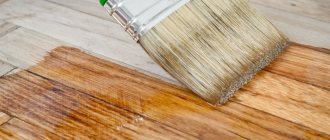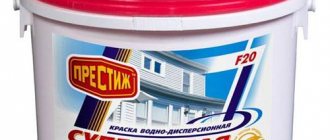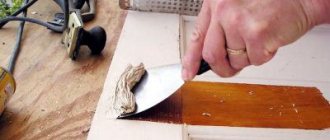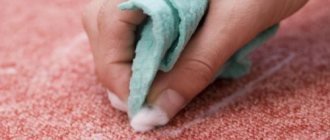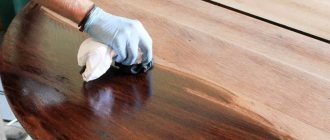Acrylic paints have a wide range of applications; they are used in exterior and interior finishing works; artists choose them as an alternative to oil-based compositions. Therefore, it is important to decide whether varnish is needed for acrylic paints, and, if the answer is positive, which type will be optimal. We will understand what features different varnish compositions have, which of them are suitable for acrylic, and what techniques will help create high-quality varnish.
Varnishing is the stage of forming the appearance Source absolut-dostavka.ru
Why do you need to varnish surfaces?
Applying varnish to a surface painted with acrylic paint may be advisable if it is wooden and susceptible to moisture. For example, a wooden table outdoors or any other wooden product intended for a room with high humidity (ground floor, basement, bathroom).
Moreover, wood is deformed under the influence of the environment. It may be susceptible to attack by pests.
And in order to avoid unpleasant surprises, it makes sense to protect wooden surfaces and products with additional protection.
Varnishing: arguments for and against
Despite the fact that acrylic paint itself forms a durable and flexible coating, the answer to the question of whether acrylic paint can be varnished is often answered in the affirmative. Varnishing provides the following additional advantages:
- The painted surface receives additional protection from abrasion and moisture.
- The varnish layer prevents contamination, preserving the original characteristics of acrylic.
- Thanks to the varnish, the gloss of the surface is evened out, the color becomes brighter and more saturated.
- The varnish layer protects the base from fading under the influence of solar ultraviolet radiation.
The varnish composition is convenient to apply with a brush Source proekt-sam.ru
- The varnished surface is easier to care for.
The following arguments are put forward against varnishing:
- Acrylic is a polymer and was not originally intended for varnishing. If the varnish is applied carelessly, it can cause the base to peel off over time.
- The varnish layer complicates restoration work, no matter whether it is a painting, a wall or furniture.
See also: Catalog of companies that specialize in paints and varnishes and related work
Classification by type of varnish
- Varnish for application on acrylic paint. This type of varnish is non-toxic and therefore safe. Suitable for indoor use. Colorless and quick-drying material.
- Varnish based on cellulose nitrates. Nitrolac. Due to its toxicity, the varnish is hazardous to health. When working with it, especially indoors, you should wear a protective mask. Dries quickly.
- Varnish based on alkyd resins, fatty acids and vegetable oils. Alkyd varnish. It takes a long time to dry. Repels moisture.
- Polyurethane varnish. Well protects wood from mechanical stress.
- Epoxy varnish. The material is moisture resistant. Protects against mechanical influences. Dries in 12 hours.
Classification by method of application
- Furniture varnish. It is used in the furniture industry for restoration work. Also applicable in construction.
- Varnish for parquet. Used for parquet floors, varnishing furniture and doors.
- Varnish for decoration. The protective functions of this type of varnish fade into the background; the appearance of the product is important for it.
- Varnish for treating wooden surfaces on boats. Yacht varnish. The peculiarity of this varnish is to protect surfaces and products from aggressive environmental influences, both in fresh and salt water, and on land.
Manufacturers
In construction markets, it is quite difficult to decide on the choice of paint and varnish material due to the wide range and large number of manufacturing companies.
There are several popular companies that produce quality products:
- Optimist is a large Russian manufacturer of paint and varnish products with a twenty-year history. The company strictly adheres to quality standards and uses high-quality materials in its work.
- VGT is a Russian company specializing in the production of varnishes, paints, enamels, pigments and other acrylic materials. The company has its own research center. Construction stores offer a wide range of products from this company.
- Tikkurila is one of the leading companies in the production of paints and varnishes in Finland, Sweden and Russia. Acrylic varnishes of this brand are in wide demand among consumers.
- Pinotex - the products of this company are famous for their quality, are in demand throughout Europe, and produce universal, waterproof, wear-resistant acrylic varnishes.
- "Lakra" produces parquet and tinted varnishes with a UV filter, the products have quality certificates.
Choosing a varnish for acrylic paint
Modern trade can offer its customers a huge selection of paint and varnish products. For every taste and budget, in any volume and any composition. From any manufacturers.
This article offers acrylic paint varnish for consideration. Why it is needed and where it is used was described above. Now let's look at how to choose such a varnish, what parameters you should pay attention to.
Main parameters for selection:
- The varnish must contain acrylic.
- The varnish must be fresh. No more than three months should pass from the moment of its manufacture.
- It is better to choose a matte varnish, since acrylic paint itself has glossy properties.
Stages of painting a wooden base
Note!
A primer will help improve the adhesion of paint to the varnish base - this is the name of a special primer that is applied to the wood in two layers. For varnish coating, a one-time treatment will be sufficient. There are many types of primer, so look for a solution recommended by the paint manufacturer.
- Apply the first layer of paint of the main shade. Most often, lacquered furniture has a deep brown color, so the base layer, through which dark wood is visible, should be light.
After the first layer has dried, apply the next layer of the main color.
Next, we paint the furniture facades with a contrasting shade. In this case it will be coral.
After the paint has dried, the entire surface along the borders is sealed with special masking tape. The borders are spray painted with a different shade.
The corners are sealed with overlapping masking tape, which is best cut into the required fragments with scissors.
Now you can paint the borders with spray paint and remove the tape.
The handles and key to the cabinets are painted gold to match the borders.
Advantages of acrylic paint varnish
Acrylic varnish is the best coating for acrylic paint, and the ideal composition of such varnish can be called polyurethane.
Advantages of acrylic varnish:
- No smell.
- Non-toxic.
- Dries quickly.
- Instant.
- Viscous.
- Excellent adhesion to acrylic and water-based paints.
- Fits perfectly on any surface.
- Remarkably protects against environmental influences.
- The varnish is absolutely transparent and thanks to this it retains all the color saturation of the paint even when exposed to sunlight.
General information
The first thing that interests home craftsmen when they are faced with a similar task is whether it is possible to paint with paint over varnish? Of course, it is best to remove the old coating, but if this is not possible, or you need to save time, then you can paint over the old coating.
True, in order to say with confidence whether it is possible to apply paint to varnish, it is necessary to clarify what kind of paint and varnish material we are talking about. The fact is that not all compositions are suitable for these purposes. For example, you cannot use nitro paint, as the old coating will begin to peel off over time.
In addition, before applying the coloring composition, the surface still needs to be prepared in a certain way.
Preparatory work
In order for the final work to be pleasing to the eye, before applying varnish it is necessary to carry out a number of actions related to preparing the surface for varnishing.
- Cleaning. Clean the surface from dirt and dust.
- Checking the surface for defects. If they are detected, the surface should be sanded and degreased.
- Varnish preparation. Before applying the varnish, it should be heated in a water bath for 5 minutes to a temperature of 50°C. When heating, the mixture must be constantly stirred.
Varnish application process
- If the product is not freshly painted, the paint has faded, then the surface should be painted again.
- Carry out all the preparatory work indicated above.
- Apply varnish only after the paint has completely dried and in good lighting.
- Varnishing should be done with a flute brush with a width of 50 to 150 mm.
- Polish with a dry brush. In a vertical position, apply with a dry brush until it sticks.
- Apply one layer, if necessary two layers of varnish.
It is important that no dust gets on the surface when varnishing. Heavy objects can only be placed after the varnish has completely dried.
Tips from a pro
If you don’t have confidence in your abilities and are afraid of ruining everything, then of course it’s better to trust a professional master. A person who knows everything about the properties of paints and varnishes and knows how to use them correctly.
If you have confidence, but little experience, let us allow ourselves some advice:
- If the surface is not painted, it should be primed before varnishing.
- Lightly sand the layers of varnish, except the last one, with fine-fiber sandpaper. This will give the surface additional shine and a mirror effect.
- You should choose a matte varnish. Firstly, acrylic paints have their own gloss. Secondly, the matte composition will be able to mask defects and errors, if any.
- You cannot dilute acrylic varnish with drying oil or solvent; if there is such a need, it is better to use clean water for this.
- Apply varnish only when the air humidity is at least 50%. If there is less humidity, the varnish will dry too quickly and crack.
- The surface to be varnished must always be degreased, for example with soapy water.
- To ensure uniform coverage, the varnish should be applied in several thin layers, if there are several of them.
Recommendations
So, if required, sanding can be done between applying two layers. Remember also that varnishing is permissible only at temperatures above +5 degrees, and the temperature of the varnish should in no case be less than +15 degrees.
If you want to get the best result, then when applying and drying, be sure to ensure that the varnished surface is safe from drafts and direct sunlight. Also, do not forget that before applying acrylic varnish for wood, the composition should be mixed well, and then you will be able to evenly distribute the additive that has sunk to the bottom and obtain a homogeneous composition. The time for mixing the varnish will depend on the volume of the container, but it is this action that will make it possible to obtain the best effect.
To apply paints and varnishes to a wooden surface, you should use special varnish applicators or brushes. After the work is completed, be sure to wipe the tools well. The condition of the surface directly affects how much varnish will be used. If we are talking about painting the floor, then take into account that the varnish will finally gain strength only after a week, and only after this time can you bring in the furniture and lay the carpet.
If the temperature after painting for some reason decreases and becomes less than +10 degrees, the drying time will double.
